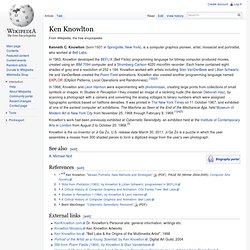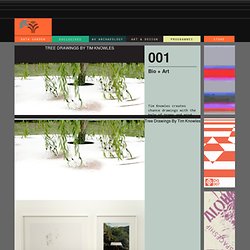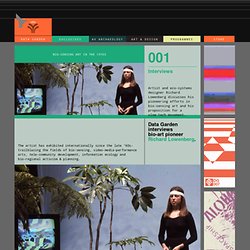

ARS Electronica. Circuit-bent Furby. Hair's natural recovery cycle - Google Scholar. Secret Life of Plants and Telepathy. Bartholomäus Traubeck. Céleste Boursier-Mougenot at Barbican Centre, London. 1/3. Experimental PROOF - PLANTS can READ YOUR MIND & have Consciousness!!! Dracaena Watering. Cleve Baxter - Plants can sense human intentions - YouTube#at=384#! How To Communicate With Plants. Ave you ever...

Wondered how a plant felt? Been drawn to a certain plant in a garden center? Plant perception (a.k.a. the Backster effect) Plants Communicate to Warn Against Danger. Plants chatter amongst themselves to spread information, a lot like humans and other animals, new research suggests.

A unique internal network apparently allows greens to warn each other against predators and potential enemies. Many herbal plants such as strawberry, clover, reed and ground elder naturally form a set of connections to share information with each other through channels known as runners—horizontal stems that physically bond the plants like tubes or cables along the soil surface and underground. Though connected to vertical stems, runners eventually form new buds at the tips and ultimately form a network of plants. “Network-like plants do not usually produce vertical stems but their stems lie flat on the ground and can hence be used as network infrastructure,” said researcher Josef Stuefer from the Radboud University in the Netherlands. Paul R. Ehrlich. Paul Ralph Ehrlich (born May 29, 1932) is an American biologist and educator who is the Bing Professor of Population Studies in the department of Biological Sciences at Stanford University and president of Stanford's Center for Conservation Biology.[2] By training he is an entomologist specializing in Lepidoptera (butterflies), and published a landmark paper about the evolution of plants and insects.[3] He is also a prominent ecologist and demographer.

Ehrlich is best known for his dire warnings about population growth[4] and limited resources. Ehrlich became well-known after publication of his controversial 1968 book The Population Bomb.[5][6] In years since, some his predictions have developed in a less alarming way than he had predicted, with population growth rates slowing and new technologies of food production implemented. Ken Knowlton. Kenneth C.

Knowlton (born 1931 in Springville, New York), is a computer graphics pioneer, artist, mosaicist and portraitist, who worked at Bell Labs. The Criterion Collection. World on a Wire (1973. Data Garden. TREE DRAWINGS BY TIM KNOWLES. Data Garden exclusives AV Archaeology Art & Design Programmes Store Bio + Art Tree Drawings By Tim Knowles Oak Tree.

Pantomation: 1977-1979. Chroma key. Today's practicality of green-screen compositing is demonstrated by Iman Crosson in a self-produced YouTube video.Top panel: A frame of Crosson in full-motion video as shot in his own living room.Bottom panel: Frame in the final version, in which Crosson, impersonating Barack Obama, "appears" in the White House's East Room.[1] Chroma key compositing, or chroma keying, is a special effects / post-production technique for compositing (layering) two images or video streams together based on color hues (chroma range). The technique has been used heavily in many fields to remove a background from the subject of a photo or video – particularly the newscasting, motion picture and videogame industries. A color range in the top layer is made transparent, revealing another image behind.
The chroma keying technique is commonly used in video production and post-production. History[edit] Process[edit] Processing a green backdrop[edit] JOHN CAGE PLAYS A CACTUS. John Cage. Not to be confused with John Cale.

John Cage Cage is perhaps best known for his 1952 composition 4′33″, which is performed in the absence of deliberate sound; musicians who present the work do nothing aside from being present for the duration specified by the title. The content of the composition is not "four minutes and 33 seconds of silence," as is sometimes assumed, but rather the sounds of the environment heard by the audience during performance.[7][8] The work's challenge to assumed definitions about musicianship and musical experience made it a popular and controversial topic both in musicology and the broader aesthetics of art and performance. Stockhausen addresses “dehumanization” in contemporary music.
Pearltrees. Data Garden interviews artist,Bartholomäus Traubeck.

Radio Event No. 20: Rhododendron. Radio Event No. 20: Rhododendron Early bio-sensing electronics wiz Tom Zahuranec invited an audience to a special radio event situated in the KPFA Music Office.

Tom had wired a Rhododendron with liquid electrode sensors which were amplified and fed into the oscillators of a Buchla Synthesizer. TEACHING A CACTUS THE JAPANESE ALPHABET. BIO-SENSING ART in the 1970s. Data Garden interviews bio-art pioneerRichard Lowenberg.

The artist has exhibited internationally since the late ’60s- trailblazing the fields of bio-sensing, video-media-performance arts, tele-community development, information ecology and bio-regional activism & planning. Brainwave and plant music from The Secret Life of Plants, 1976. Thanks for joining us for our first interview! Can you brief us on the origins of your bio-communication art? Bio-sensing electronics - Google Scholar. Radio Event No 13: "Bucket - Ful Mercury Walk" by Tom Zahuranec. <div style="padding:5px; font-size:80%; width:300px; background-color:white; margin-left:auto; margin-right:auto; border:1px dashed gray;"> Internet Archive's<!

--'--> in-browser audio player requires JavaScript to be enabled. It appears your browser does not have it turned on. Please see your browser settings for this feature. </div> Broadcasted live from the Mills College Electronic Tape Music Center via a remote portable transmitter, Tom Zahuranec's "Bucket-Ful Mercury Walk" invited listeners at home to drive to Mills and assist in creating sounds using various electronic equipment including Moog and Buchla synthesizers.
This audio is part of the collection: Other Minds Audio ArchiveIt also belongs to collections: Music, Arts & Culture; stream_only. Mount Roraima. Mount Roraima (Spanish: Monte Roraima [ˈmonte roˈɾaima], also known as Tepuy Roraima and Cerro Roraima; Portuguese: Monte Roraima [ˈmõtʃi ʁoˈɾɐ̃jmɐ]) is the highest of the Pakaraima chain of tepui plateau in South America.[4]:156 First described by the English explorer Sir Walter Raleigh in 1596, its 31 km2 summit area[4]:156 consists on all sides of cliffs rising 400 metres (1,300 ft).
The mountain also serves as the triple border point of Venezuela, Brazil and Guyana.[4]:156 Mount Roraima lies on the Guiana Shield in the southeastern corner of Venezuela's 30,000 square kilometres (12,000 sq mi) Canaima National Park forming the highest peak of Guyana's Highland Range. The tabletop mountains of the park are considered some of the oldest geological formations on Earth, dating back to some two billion years ago in the Precambrian. WikiMiniAtlas Flora and fauna[edit] The Secret Life of Plankton. TONE SCIENCE. Non-Euclidean geometry. Behavior of lines with a common perpendicular in each of the three types of geometry In mathematics, non-Euclidean geometry consists of two geometries based on axioms closely related to those specifying Euclidean geometry.
As Euclidean geometry lies at the intersection of metric geometry and affine geometry, non-Euclidean geometry arises when either the metric requirement is relaxed, or the parallel postulate is set aside. In the latter case one obtains hyperbolic geometry and elliptic geometry, the traditional non-Euclidean geometries. Science resources. Khan Academy. Vampire Squid from Hell (3200 Feet Under Sea Level)
Bathysphere. The Bathysphere (Greek words βάθuς (bathus), "deep" and σφαίρα (sphaira), "sphere") is a spherical deep-sea submersible which was unpowered and lowered into the ocean on a cable, and was used to conduct a series of dives off the coast of Bermuda from 1930 to 1934. The Bathysphere was designed in 1928 and 1929 by the American engineer Otis Barton, to be used by the naturalist William Beebe for studying undersea wildlife. Beebe and Barton conducted dives in the Bathysphere together, marking the first time that a marine biologist observed deep-sea animals in their native environment. Their dives set several consecutive world records for the deepest dive ever performed by a human. The record set by the deepest of these, to a depth of 3,028 feet on August 15, 1934, lasted until it was broken by Barton in 1949.
Origin and design[edit] William Beebe. William Beebe /ˈbiːbi/, born Charles William Beebe (July 29, 1877 – June 4, 1962)[2] was an American naturalist, ornithologist, marine biologist, entomologist, explorer, and author. He is remembered for the numerous expeditions he conducted for the New York Zoological Society, his deep dives in the Bathysphere, and his prolific scientific writing for both academic and popular audiences. Paranormal. Suppressed Technology.
Spermine. News and information about meteor showers, solar flares, auroras, and near-Earth asteroids. The Neuroscience Of Music. What the Bleep Do We Know!?™ & What the Bleep!? - Down the Rabbit Hole. Water, Consciousness & Intent: Dr. Masaru Emoto. Water has Memory. TAKE ACTION FOR JAPAN -Emoto Peace Project-: 11.11.11 в 11:11 clearing cloud game 2. 11.11.11 в 11:11. MAGNET MOTOR L ENERGIA INFINITA GRATIS ESISTE!!!!LEGGI !! Schools of fish help squeeze more power from wind farms. 8 August 2011Last updated at 19:57 By Hamish Pritchard Science Reporter How Caltech's new wind farm design looks. Electromagnetism. Fundamental interaction. Fundamental interactions, also called fundamental forces or interactive forces, are modeled in fundamental physics as patterns of relations in physical systems, evolving over time, that appear not reducible to relations among entities more basic.
Four fundamental interactions are conventionally recognized: gravitational, electromagnetic, strong nuclear, and weak nuclear. Everyday phenomena of human experience are mediated via gravitation and electromagnetism. The strong interaction, synthesizing chemical elements via nuclear fusion within stars, holds together the atom's nucleus, and is released during an atomic bomb's detonation.
The weak interaction is involved in radioactive decay. Potato Power. Introduction In this activity, you will learn how to build a battery from potatoes. Make electricity from Potato? Geomancy. Geomancy tool. INDIGO CHILDREN - CHRYSTALLINE CHILDREN. REAL Telekinesis Training, How to do telekenisis, Eagle Warrior Training. 28days. How To Move Matter Over Mind. See Energy in the Air. Learn to See the Human Aura in 5 Minutes.
How To See AURAs. Aura - Learn to see your Aura image with your own eyes. Resonance. Law of Attraction: Aligning with Vibrations. Inedia. Sathya Sai Baba.